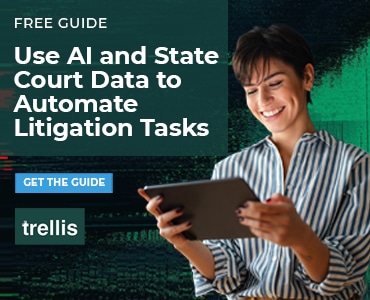Litigation is a conservative profession, slow to adapt to change, which has prompted a raft of cautionary missives by practitioners about the perils of using AI. But lawyers who resist embracing AI risk falling behind and, ultimately, doing a disservice to clients. Trial attorneys Marissa Ronk and Miles Orton explore the specific ways to deploy generative AI for litigators.
Table of contents
AI’s recent advances and opportunities for use in litigation stem from the application of machine learning — the capacity of computers to teach themselves and learn from experience — and improvements in natural language processing, or a computer’s capacity to understand the meaning of human speech and to use this to perform human-like analysis. These developments have improved generative AI’s ability to analyze and identify patterns and connections within enormous amounts of data and generate clear, cogent summaries of relevant issues. These advances create enormous opportunities to improve the practice of law.
Using AI, however, comes with significant risks, like hallucinations, where AI models trained on large language models assert fictitious “facts” with confidence, and confidentiality concerns regarding information fed to AI models that lack sufficiently robust security guarantees. Lawyers’ sloppy use of AI risks running afoul of numerous rules of professional conduct, including the duties of competence, communication and candor, as well as the responsibilities of supervisory lawyers and of all lawyers to correct misapprehensions known to have arisen in a matter.
Let’s review specific ways litigators and litigation and trial teams can use AI in litigation today.
Generative AI for Litigators: 5 Key Deployments
Discovery
Technology-assisted review (TAR) has been a staple of e-discovery practice for nearly two decades. TAR uses machine learning to assist attorney reviewers in identifying key materials within large troves of documents and in developing a degree of confidence that they have identified key relevant or privileged materials. TAR does so by relying on iterative cycles of machine suggestions and human review.
The next key leap for e-discovery will be the application of generative AI, which can be used to analyze databases, identify key documents with limited guidance, generate summaries, and provide links to specific documents on key issues. Unlike TAR, GenAI relies on well-crafted prompt engineering to categorize documents according to highly specific issues. Previously, attorneys would have to undergo substantial and costly document review to trace, for example, when a witness first became aware of an issue, who they discussed it with, and what they discussed. GenAI will be able to provide an initial summary of and cites to responsive materials much faster and at lower cost.
GenAI will not replace TAR in the document review process, but augment it, pinpointing portions of a document that impacted its recommendations and offering other factors to consider before the reviewer makes a final call on the material’s importance. While skilled attorneys will still need to provide quality control input in a hybrid AI-human review process, as well as check the AI’s summaries and citations and test their accuracy and completeness, this will obviate the previous need for costly human review of thousands of documents to reach the same results, giving attorneys a faster, earlier roadmap of key evidence.
Legal Research
AI-assisted research tools are already baked into Westlaw and LexisNexis. The key benefits are streamlining and saving time on research. Here too, attorneys will need to verify that AI-assisted research is providing the right answers by testing the AI’s results using traditional research techniques. But, like the transition from book research to electronic research only a few decades ago, AI-assisted research promises to be far more efficient — less time-intensive for attorneys and less costly for clients.
Drafting
AI should ultimately be deployed in nearly all stages of legal drafting. Short-term, AI’s best use is in analyzing and providing suggestions for materials already written by attorneys, rather than drafting original documents. For example, programs such as BriefCatch, Grammarly and Microsoft’s Copilot now include AI tools that go beyond grammar and spell checking, also offering suggestions for clarity, concision, flow and engagement. “Professional grade” legal tools like Harvey AI and Thomson Reuters CoCounsel offer even broader capabilities for generating work product and assisting in ideation.
Longer-term, AI could be a useful tool for drafting sections and ultimately entire first drafts of substantive litigation materials. Today, practitioners commonly identify and draw from high-quality templates to draft litigation materials. AI can draw from a much larger repository of samples and put together initial drafts much more quickly. For example, AI could assist in initial drafting of pleadings, helping plaintiffs ensure that they satisfy notice pleading requirements, and helping defendants readily spot pleading deficiencies.
But two key risks caution against using AI to create original drafts of complex litigation materials:
- The danger of hallucination.
- The risk of missing important facts or context.
Hallucination is the most frequent and visible pitfall of lawyers using AI tools, routinely leading to sanctions for citing fictitious authority fabricated by AI. But perhaps just as dangerous, defaulting to AI for drafting risks missing key facts or arguments that may lead to a better outcome. At their current stage, AI tools are instead more useful at the drafting stage for iterative refinements of human-generated content, as well as assisting in ideation, strategy development, and anticipating an adversary’s arguments (e.g., “Give me the top three arguments for a potential motion to dismiss this draft complaint”).
Key parts of drafting litigation materials will need to stay firmly in the hands of attorneys. This is because litigation requires intimate knowledge of the evidentiary record, the key litigation risks and opportunities, collateral consequences of potential positions, and of opposing counsel and the judge, just to name a few. Lawyers’ critical reasoning skills, informed by experiential learning that AI tools lack, are essential and irreplaceable tools in providing competent representation.
Predictive Analytics
AI can also soon be used to assist attorneys in fine-tuning their litigation predictions. Clients often seek answers to the tremendously difficult questions about the odds of success of a particular claim, defense or motion, or the likely size of a judgment. Attorneys historically develop answers to these questions based on their and their colleagues’ experience, their knowledge of the case, and subjective knowledge of the jurisdiction and jury pool. AI will complement these sources of information with predictive analytics based on hard data. Attorneys will still have a role in ensuring that AI is correctly identifying and drawing from comparable cases, but AI’s ability to parse vast amounts of data faster than humans will save time.
At Trial
Trial is a uniquely relational experience — among the attorneys, the judge and the jury. These relationships require emotional intelligence, common sense and the ability to build rapport and trust, in addition to the factual and legal expertise honed from mastering the evidentiary record and applicable law. AI is unlikely to supplant actual attorneys in trying a case, but it can be helpful in assisting attorneys with certain trial aspects.
AI can, for example, assist attorneys in jury selection by rapidly identifying and parsing publicly available information about potential jurors and offering recommendations on whether they meet a particular juror profile. Attorneys and jury consultants do this research already but are limited by the compressed timeframe for juror selection. AI tooled to search public social media information or court records could be deployed to identify and summarize far more information relevant to potential juror bias, fast enough to assist attorneys during the juror selection process in real time. This would provide attorneys otherwise-undiscovered information relevant to whether to move for cause or use a peremptory challenge.
However, asking AI models to recommend if jurors meet a particular juror profile will introduce a new risk attorneys will need to guard against: bias. LLMs can amplify biases and perpetuate stereotypes. This can foreseeably lead to Batson challenge scenarios, where an AI provides recommendations against selecting certain jurors based on impermissible grounds, such as race.
AI can also offer substantial promise in the use of exhibits. Trial lawyers will still need to devote sufficient time and attention to know the universe of key exhibits, but identifying responsive exhibits or impeachment material on the fly can be made even easier if the evidentiary universe can be fed to an AI and it can provide candidates instantly. Just as a few examples, “show me a list of exhibits and their key language involving [issue] from between [date range],” or “what did [deponent] say about [topic] during her deposition?”
AI will also likely eventually prove helpful in generating demonstratives. Natural language prompts will make it easy for attorneys to describe to AI the kinds of demonstratives they’d like created. AI has the additional benefit of speed: attorneys will be able to make immediate adjustments during trial to further tailor the demonstrative.
Longer-Term Potential Uses for AI in Litigation
Longer-term, AI could be deployed in even more complex areas of litigation where attorney skill and judgment are critical and currently non-delegable. Because litigation is such a relational experience and depends fundamentally on judgment and emotional intelligence, AI’s longer-term role should remain as a supportive and valuable co-pilot to attorneys, rather than replacing attorneys entirely. The entire legal industry, however, will need to train itself to use these powerful new tools responsibly; attorneys who stick with the pre-AI status quo will ultimately fall behind and do a disservice to their clients.
Image © iStockPhoto.com.

Sign up for Attorney at Work’s daily practice tips newsletter here and subscribe to our podcast, Attorney at Work Today.















